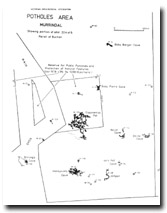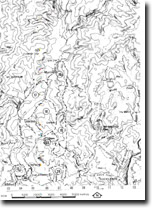8523-18 The Potholes Area
Sites 8523 (8522) 16 to 30 - The Buchan/Murrindal Limestone Basin
This information has been developed from the publications:
|
Location: | 055545. 8 kilometres north of Buchan adjacent to the Buchan Murrindal Road. | 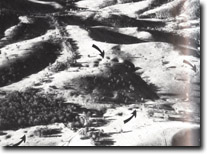 The Potholes area. Solution dolines (arrowed) |
Abstract: | Surface karst limestone features and caves. | |
Access: | Buchan - Gelantipy Road. | |
Ownership: | Private land with small Crown reserve. | |
Geology: | The Rocky Camp Member and the McLarty Member of the Murrindal Limestone outcrop in this area. The Rocky Camp Member consists of massively bedded and interbedded biohermal limestones which are richly coralline and contain predominantly tabulate corals and stromotoporoids, with Receptaculites as a common associate. The massively bedded limestones of the McLarty Member become increasingly corraline and biostromal units appear within them in this area and further to the north. As a consequence, it is difficult to determine the boundary between the two limestone members. The McLarty Member Limestones at this locality are richly fossiliferous and apart from corals contain brachiopods, e.g. Spirifer, Atrypa, and Hypothyridina, the trilobite Calymne, and the echinoid Scutellum. Thin black shale beds are contained in the limestone. These occur partly in gulls up to 10 cm wide, either along bedding planes, or as insoluble residue along styolites. In addition the limestones are strongly jointed along three planes striking at 60 degrees to each other. This jointing pattern has largely dictated cave development in the area as most of the cave passages are enlargements of these joints. | |
Geomorphology: | As the name suggests the Potholes area is significant for its concentration of sinkholes. There is little karst topography in Victoria, and even in the limestone country around Buchan doline karst relief is not well developed. However, the concentration of dolines, together with surface rillenkarren, at the Potholes constitute the finest example of this form of karst topography in South-eastern Australia. Many of the dolines open into cave entrance and more than 90 caves are recorded in this area. Many of the caves consist almost entirely of vertical pitches with little horizontal development. Ians Hat Cave (M-54) and Jam Pot (M-48) are of this type, the former is the deepest cave thus far recorded in Victoria (over 70 m). Several caves have developed extensive horizontal passage systems by the enlargement of joint planes. Such caves tend to have narrow passages with high ceilings which open occasionally into large chambers. The passages and chamber floors consist of waterworn rock, muds or flowstone, while many of the caves finish in soaks with mud and gravel bottoms. Cave decoration is best developed in this latter type of cave and features such as flowstone, stalactites, stalagmites, shawls, rimstone pools and helictites are common. The cave, Exponential Pot (M-125), has the most beautiful of this decoration and is among the best decorated of the caves yet discovered in the Buchan region. Although this cave is incompletely surveyed, more than 1500 m of passages have been mapped which extend down to depths of approximately 60 m. Other similar cases occur, the most notable of which is Honeycomb Cave (M-41). Ragnarok Cave (M-16), exhibits excellent examples of rare mudflow features such as dendritic surge marks. | |
Significance: | National. The area contains the best example of doline karst topography and associated cave formats in south-eastern Australia. In addition this area exhibit’s the best examples of joint controlled cave development in Victoria and also some of the best cave decoration in the Buchan area. | |
Management: | The generalized management prescriptions outlined apply to this locality. The uniqueness of the topography and the excellence of the cave decoration warrant the extension of the small reserve to include the many important caves presently on private land. | |
References: | Stirling, J. 1887. 'The physiography of the Tambo Valley', Ibid, 1(2) :37-66. Kitson, A.E. 1907. 'Proposed reservation of limestone caves in the Buchan District, Eastern Gippland', Rec. geol. Surv. Vict., II(I) :37-44. Tiechert, C. and Talent, J.A. 1958. 'Geology of the Buchan area, East Gippsland', Mem. geol. Surv. Vict., 21: 1-56. Sweeting, M.M. 1960. 'The caves of the Buchan area, Victoria, Australia', Z. Geomorph. Suppl., 2 :81-89. Matthews, P.G. (ed) 1968. Speleological Handbook. Victorian Speleological Association. Matthews, P.G. (ed) 1979. Checklist of Australian Caves and Karst. Australian Speleological federation. Nicoll R.S. and Brush, J.B. 1976. Guidebook to the caves of South Eastern N.S.W. and Eastern Victoria. A.S.F. Guidebook No.1. White, N.J. and Davey, A. 1977. 'Pollution of Moons Cave, Buchan, Victoria : A Case Study in Cave Reserve Management', Proc. 11th Biennial Conference, Australian Speleological Federation. Canberra, 1976. Victorian Speleological Association 1979. 'The Potholes Area, Murrindal, Victoria. V.S.A., Melbourne. | |
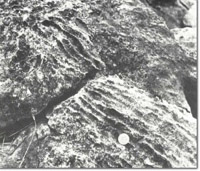 Rilenkarren on limestone at The Potholes. | 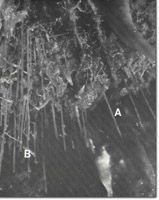 Exponential Pot (M-125). Fragilecave decorations; straws (A)and helictites (B). | |
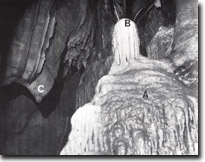 Exponential Pot (M-125). Flowstone (A). Stalagmite (B). Shaw decoration (C). |

